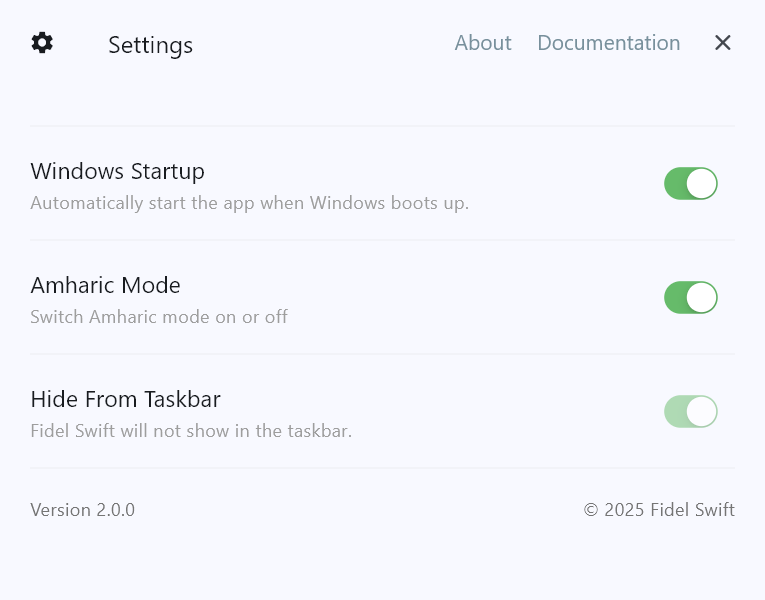Quick Start Guide
The Quick Start Guide will help you get up and running with Fidel Swift Amharic Keyboard in just a few minutes. Once installed, the app is ready to use instantly with no need for font installation, language switching, or technical configuration.
Launching Fidel Swift
After installation, Fidel Swift will run automatically and appear in your Windows system tray, located in the bottom-right corner of your screen near the clock.
- You’ll see a tray icon that looks like this:

💡Note:
If the icon is hidden, click the small upward arrow (^) in the system tray to reveal hidden icons.
Start Typing in Amharic
Open any app that accepts text input—such as:
- Notepad
- Microsoft Word
- WhatsApp Desktop
- Google Docs
- Email clients
- Web browsers (input fields, forms)
Then begin typing using Amharic phonetics.

Example Inputs:
| Type This | You Get |
|---|---|
| Slame | ሰላም |
| Zmne | ዘመን |
| Fidl | ፊደል |
| Adise Abba | አዲስ አበባ |
You don’t need to change your Windows input language or switch keyboard layouts.
Switch Between Amharic and English Mode
Sometimes, you’ll want to type in English. You can quickly toggle Fidel Swift on/off:
Using the Fidel Swift Setting window:
- Right-click the Fidel Swift tray icon
- Select “Setting” to open setting window
- Go to Amharic Mode section and toggle the switch button to enable amahric mode
Using a Keyboard Shortcut (Default):
- Press Alt + A to toggle Amharic mode on or off
- When off, all keystrokes behave like standard English typing

Behavior Overview
| Feature | Description |
|---|---|
| Phonetic Typing Engine | Automatically converts Latin keystrokes to Amharic. |
| Live Conversion | Text appears in Amharic as you type—no delay. |
| Intelligent Buffering | Tracks recent input and forms correct syllables. |
Tips for New Users
- Type naturally: You don’t need to pause or slow down.
- Use lowercase: Most mappings expect lowercase input.
- Undo (Ctrl+Z) still works even after Amharic syllables are formed.
 Previous
Previous